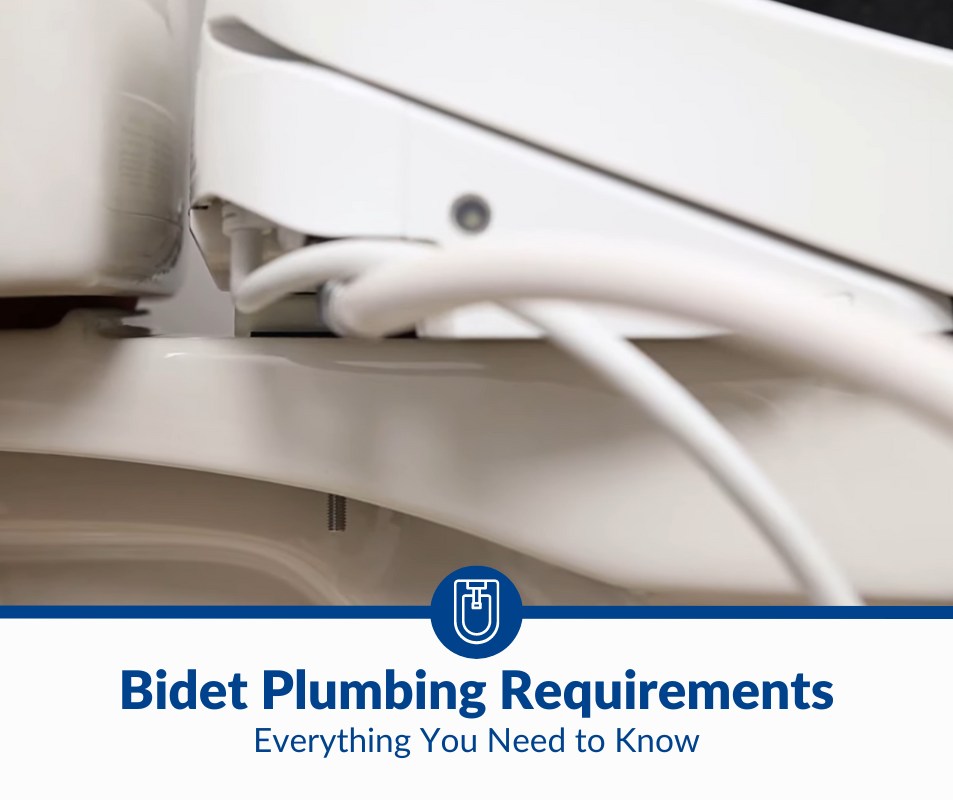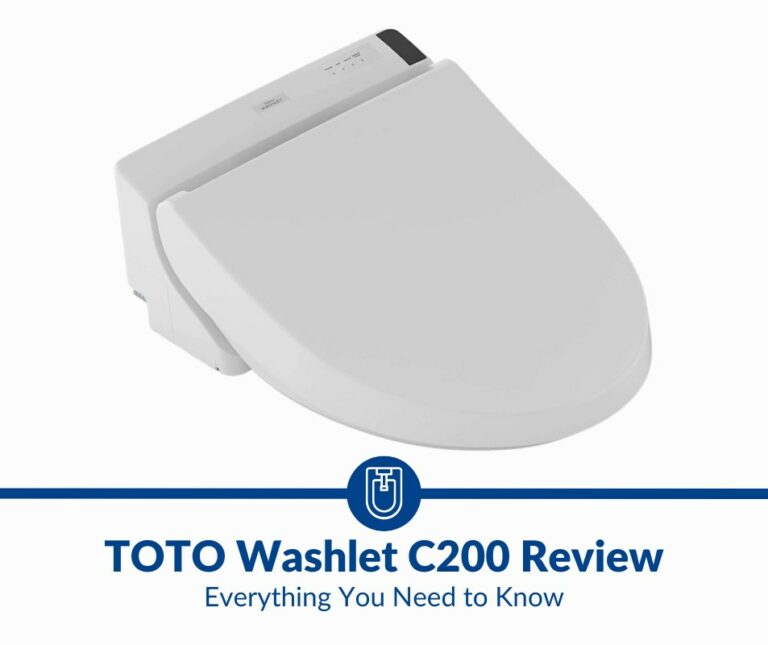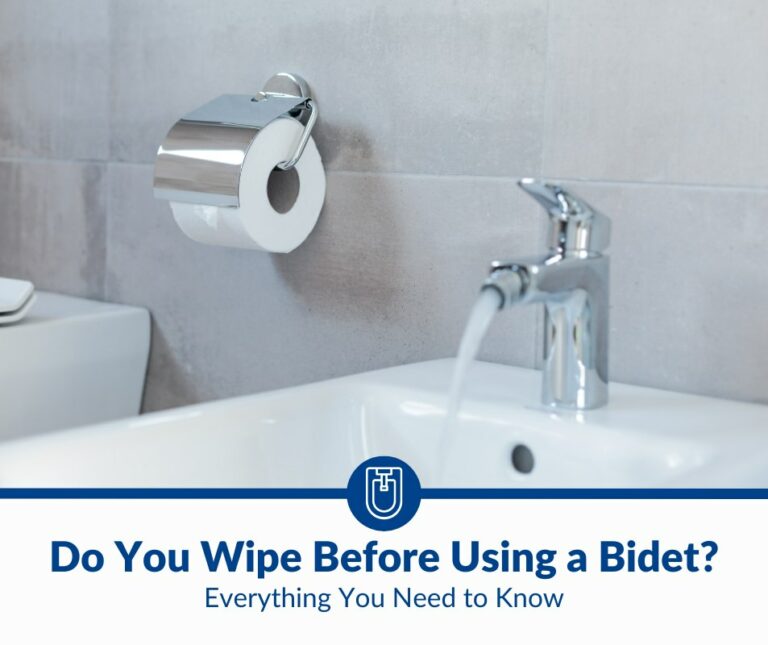Bidet Plumbing Requirements: The Complete Guide
Bidets have similar plumbing requirements to toilets. However, standalone bidets often need their own water line (and sometimes their own electrical outlet). Bidet seats and attachments can often be mounted to most toilets, but they have unique plumbing requirements to ensure they get enough water pressure.
Bidet plumbing requirements include a 1.25” P-trap, a backflow valve, a ⅜” shutoff valve (and an extra one if you want a hot water line), and a 1.25” drain stub-out for the floor or the wall. You’ll also need 1.25” PVC plumbing in the wall connected to the sewer line.
Throughout this post, I’ll explain the basic bidet plumbing requirements, whether or not you need permission to install a bidet, and several installation tips to help you out along the way.
Does a Bidet Require Special Plumbing?
A bidet requires special plumbing because you need to install water inlets and outlets. Some bidets have T fittings that connect to the toilet and the bidet, whereas other bidets connect directly to the wall’s plumbing. Some bidets connect to the floor, which requires stub-outs below the bidet tank.
The good news is that most bidets use similar fittings and pipes as toilets. This means that you can get all of the components for both installations in the same section at the store.
However, each type of bidet has its own special plumbing requirements. Let’s analyze them below.
Standalone Bidet Plumbing
Standalone bidets have the most demanding plumbing requirements. They need the following parts to function properly:
- P-traps to prevent dangerous gases to flow into the bidet
- Backflow valves to keep water and urine from coming back
- A stub-out wherever the water leaves the bidet
- Shutoff valves for hot water and cold water lines
Most standalone bidets need 1.25” PVC fittings for the stub-out, P-trap, and backflow valve. Furthermore, ⅜” valves are ideal for the vast majority of water inlets. That being said, it’s best to check the manufacturer’s guidelines beforehand.
Bidet Attachment Plumbing
Bidet attachments often use T-adapters to connect the bidet to the toilet’s water inlet. These adapters range between ⅜” to ⅞”. Check your toilet’s water inlet dimensions before choosing which adapters you need.
Additionally, bidet attachments often need braided plumbing hoses to connect the bidet to the T-adapter. These hoses thread onto the bidet and use a built-in rubber washer to prevent it from leaking. If your bidet attachment doesn’t have a rubber washer, you’ll need Teflon tape to achieve a watertight seal.
Bidet Seat Plumbing
Bidet seats often use the same plumbing as bidet attachments. The only difference is that they replace the whole seat assembly, including the toilet lid. On the other hand, bidet attachments mount to the rim of the toilet under the existing lid and the seat.
Note: If your non-electric bidet has a hot water feature, you’ll need to connect it to the hot water inlet under the sink. Alternatively, you may hire a plumber to run a hot water line specifically for the bidet. These inlets range between ⅜” to ⅞”. Electric bidets can plug into nearby wall outlets to provide heat for the water and seat.
Does a Bidet Use the Same Plumbing as a Toilet?
A bidet sometimes uses the same plumbing as a toilet, especially if it’s a bidet seat or a bidet attachment. However, standalone bidets use their own plumbing that doesn’t connect to the toilet’s plumbing. Standalone bidets need their own systems because they don’t flush toilet paper or feces.
Here’s what you need to know about bidets using the same plumbing as a toilet:
- Bidet attachments and bidet seats almost always use the same plumbing as the toilet. This is because they mount onto the toilet, which means they need access to nearby plumbing. There’s no point in adding extra stub-outs if you can put a T-adapter on the toilet’s water inlet to connect the bidet.
- Bidets usually use the same fittings as most toilets. Even if you’re using different stub-outs or connecting the bidet to the sink’s water inlets, you’ll likely need the same fitting sizes. Standard bidet and toilet fittings are 1.25”, 1.5”, and sometimes 2”. Water inlets and outlets for bidets and toilets are typically ⅜”.
- Standalone bidets often don’t use the same plumbing as the toilet because they get rid of debris differently. Toilets flush feces and toilet paper, whereas bidets only move liquids down a drain. They don’t flush (unless you have a bidet seat or attachment connected to the primary toilet). This means they need their own plumbing setup.
Bidets and toilets have similar plumbing systems, and they both end up in the same sewer line. However, it’s important not to clog your bidet by using the wrong fittings or pipes. Following the manufacturer guidelines is a surefire way to ensure you’re using the right plumbing for your bidet. Never eyeball it or guess which fittings you need for your toilet and bidet setup.
Can a Bidet Cause Plumbing Problems?
A bidet can cause plumbing problems if you don’t have enough water pressure, if the plumbing isn’t wide enough, or if you flush something solid down the bidet. Some bidets cause plumbing issues when you don’t use enough Teflon tape or silicone sealant. Thankfully, all of these issues are avoidable.
Let’s take an in-depth look at each of these issues:
- Bidets can use a lot of water, reducing the pressure in other parts of your home. If your home already has water pressure issues, expect them to worsen while you’re using the bidet. This means you might experience pressure drops in showers, other toilets, sinks, dishwashers, and more. Adjust the water pressure regulator accordingly for the bidet to work properly.
- Narrow bidet plumbing reduces incoming and outgoing water pressure while increasing the likelihood of clogs. It’s important to find out what plumbing size you need from the manufacturer. Even a size reduction as small as ¼” is enough to make a massive difference in your plumbing and water pressure.
- Flushing anything other than water down a standalone bidet can mess up the plumbing. Bidets aren’t designed to flush toilet paper. While many of them have air dryers, some of them require throwing toilet paper in the toilet rather than the bidet. Liquids are the only thing that should go through a bidet’s plumbing.
- A lack of Teflon tape or silicone sealant can cause plumbing problems with your bidet. Some bidet fittings have rubber washers that can prevent leaks, too. It’s important to test your bidet for leaks before using it by turning it to its highest water pressure setting for 30 seconds, then inspecting the plumbing.
Bidet attachments and seats rarely cause plumbing issues. In fact, they usually only cause problems if your home has limited water pressure or if they’re installed incorrectly.
On the other hand, standalone bidets use more water and require their own plumbing line. Proper maintenance and installation will greatly reduce the chances of dealing with plumbing problems.
Do Bidets Need a Hot Water Line
Bidets need a hot water line if you have a non-electric bidet with hot water features. However, some electric bidets can heat incoming water from a cold water line, which means you only need one inlet. Standalone bidets usually have hot and colder water lines.
So, how do you know if your bidet needs a hot water inlet?
- Check the user’s manual to find out if it needs one or two water lines. Plenty of people use bidets with only one water inlet. If your bidet only includes one water line, it doesn’t need a hot water inlet. Never connect a bidet to the hot water inlet if you have a single line, as it could cause severe burns and plumbing problems.
- If you have an electric bidet with a plug or wires that require an electrician, your bidet likely doesn’t need a hot water line. An electric bidet can heat incoming water and warm the seat. Some of them even have adjustable nozzle directions and water pressure adjustments powered by electricity.
- Look for a thermostat or temperature knob on your bidet. Temperature knobs are very common with non-electric bidets that need hot water lines. On the other hand, digital thermostats are tied to electric bidets. You can’t have a non-electric bidet with a built-in digital thermostat because there’s nothing to power it.
Another factor to consider is whether or not you want hot water going to your bidet. If you don’t care about having hot water coming through your bidet, you don’t need to plumb the hot water line (even if it has one). Simply attach the cold water line to the bidet, then put a cap on the hot water line (⅜” or ⅞”, depending on the water inlet’s dimensions).
Not all bidets use hot water. Contrary to popular belief, you don’t need an electric bidet to enjoy warm water when cleaning up after using the toilet. This fact remains true for bidet attachments and seats, too.
That being said, it’s essential to know whether or not you’re allowed to install a bidet where you live or work. After all, a bidet’s special plumbing requirements often call for professional plumbers if you need stub-outs. Let’s explore more of these issues in the following section.
Do I Need Permission To Install a Bidet?
Bidets are becoming increasingly popular in the United States as more people recognize their many benefits. But before you install a bidet in your home, you might need permission from your landlord or homeowners association.
If you live in an apartment or condominium building, check your lease agreement or building regulations to see if there are any restrictions on installing a bidet. If you own a home, you should check your local plumbing code to confirm if there are similar restrictions.
In most cases, you will not need special permission to install a bidet. However, there are some states that require a licensed plumber to install one. This is because by installing it yourself, you risk contaminating your home and your neighbor’s water system.
Plumbing Tips for Installing a Bidet in Your Home
If you’re looking to add a bidet to your home, you’ll need to consider a few things. Plumbing is one of the most important factors to keep in mind, as improper installation can lead to big problems down the road. Here are six tips to help you get started:
Know the Anatomy of Your Bidet
If you’re planning to install a bidet in your home, it’s important to know the anatomy of the device.
Bidets come in different models, designs, shapes, and sizes. The most common type is the electronic bidet, which has a control panel that allows the user to adjust the water temperature and pressure. There are also manual bidets, which have a lever that controls the water flow.
Knowing the different parts of the bidet will help you choose the right model for your needs and install it correctly. It will also help you troubleshoot any problems you may encounter during installation.
Use Proper Fittings
One of the most important things to keep in mind when installing a bidet is to use proper fittings. This includes using the right type of:
- Faucets
- Shutoff valves
- Drain lines
- Backflow preventers
Using improper fittings can lead to several problems, including leakages, water damage, and increased bills. It can also be dangerous if the fittings are not installed correctly.
Therefore, it’s essential to use proper fittings when installing a bidet in your home. This will ensure that you enjoy all the benefits that bidets offer without any risks.
Connect the Right Water Supply
When it comes to your plumbing, it’s important to make sure that you connect the right water supply when you install a bidet in your home. This is because the water used for your home bidet needs to be clean and free of bacteria or contaminants.
If you connect the wrong water supply, you could expose yourself and your family to harmful bacteria and contaminants.
In addition to connecting the right water supply, you also need to make sure that you install the bidet in a location that is easily accessible and close to a drainage area. This is because the water used to power the bidet will need to be drained after each use. If you don’t have a drainage area nearby, you may consider installing a floor drain near the bidet.
Consider the Location of Your Toilet
When planning to install a bidet in your home, one of the most important factors to consider is the location of your toilet.
For instance, standalone bidets must be installed next to toilets for easy access. If it’s too far from your toilet, you’re likely to forget to use it, or you may not have the time to use it when you need to.
In addition, when installing toilet seat bidets, the controls should be as close to the toilet as possible. If the controls are located too far away, you may not be able to use the bidet as effectively.
Consider the Size of Your Bathroom
Bidets are great additions to any bathroom, providing a convenient way to clean yourself after using the toilet. But before installing a bidet in your home, it’s important to consider the size of your bathroom.
If you have a small bathroom, you may opt for a wall-mounted bidet. These bidets take up less space and can be installed easily. If you even have a smaller bathroom, it’s best to stick to bidet sprayers as they don’t require more plumbing than standalone ones.
If you have a larger bathroom, you may want to choose a floor-mounted bidet. It’s usually more comfortable to use and allows for more adjustability.
Follow the Manufacturer’s Instructions
When you are ready to install your bidet, be sure to read and follow the manufacturer’s instructions carefully. This will ensure the proper function and longevity of your bidet.
Here are a few key reasons why it’s important to follow the manufacturer’s instructions when installing a bidet:
- The instructions will ensure that you are installing the bidet correctly. This is important for both the proper function of the bidet as well as your safety.
- The manufacturer’s instructions will usually contain important information about the care and maintenance of your bidet. This information can help you keep your bidet in good condition and make it last longer.
- Following the manufacturer’s instructions can help you avoid voiding the warranty on your bidet.
If you’re unsure how to install a bidet, it’s best to hire a professional. However, if you’re determined to do it yourself, read the manufacturer’s instructions carefully before you start.
Final Thoughts
Bidet plumbing requirements are much stricter when you want a standalone model. If you’re happy with a bidet seat or a bidet attachment, you won’t need very many tools or plumbing parts. In fact, bidet attachments can often be installed in as little as 5 minutes.
Sticking to the aforementioned plumbing requirements will prevent leaks and clogs.







